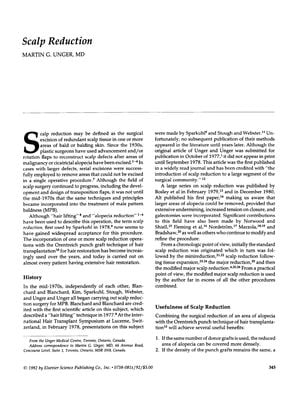TLDR Scalp reduction surgery can effectively treat male pattern baldness when tailored to the patient and performed with care to minimize complications.
In 1992, Martin G. Unger, MD, discussed the use of scalp reduction surgery for treating male pattern baldness, highlighting its benefits and techniques. The surgery, which involves excising bald areas of the scalp, was often combined with hair transplantation to improve coverage and conserve donor areas. It was most effective for individuals with specific classes of alopecia and sufficient scalp laxity. Unger's study on 56 patients found a low incidence of stretch-back using Dexon sutures. However, the bilateral lateral scalp reduction technique had a high rate of complications like scalp necrosis, leading to its abandonment by the author and others. The Unger modified major reduction, developed as a safer alternative, became the preferred method in Unger's practice. The document emphasizes the importance of tailored surgical approaches, moderate tension during closure, and avoiding excessive skin removal to minimize complications. When performed correctly, the likelihood of complications is low, and scalp reductions can be a valuable part of hair restoration strategies.
 14 citations
,
May 1988 in “The Journal of Dermatologic Surgery and Oncology”
14 citations
,
May 1988 in “The Journal of Dermatologic Surgery and Oncology” The conclusion is that bilateral lateral scalp reduction has a high risk of severe complications, leading doctors to stop using it.
31 citations
,
August 1986 in “Plastic & Reconstructive Surgery” Nonabsorbable sutures cause less wound stretching and scarring than absorbable ones.
 5 citations
,
March 1985 in “Head & Neck Surgery”
5 citations
,
March 1985 in “Head & Neck Surgery” Combining scalp reduction and hair transplants improves coverage and appearance for male baldness.
 40 citations
,
December 1980 in “The Journal of Dermatologic Surgery and Oncology”
40 citations
,
December 1980 in “The Journal of Dermatologic Surgery and Oncology” An improved scalp reduction technique reduces the need for hair grafts and has minimal complications.
 October 2023 in “Facial Plastic Surgery”
October 2023 in “Facial Plastic Surgery” Beard hair is the best for body hair transplants, but the procedure is complex and requires experienced professionals.
 October 2021 in “Indian Journal of Plastic Surgery”
October 2021 in “Indian Journal of Plastic Surgery” You can use hair from other parts of the body for scalp hair restoration.
2 citations
,
September 2017 Hair and scalp diseases can affect hair transplant success in Asians, and managing them is crucial.
 22 citations
,
January 2017 in “Indian Dermatology Online Journal”
22 citations
,
January 2017 in “Indian Dermatology Online Journal” Body hair transplants can treat baldness but differ from scalp hair and need more research on long-term results and side effects.
1 citations
,
November 2005 in “Hair transplant forum international” Understanding scalp conditions is crucial for successful hair transplants.
30 citations
,
August 2004 in “British Journal of Plastic Surgery” Chest hair can be successfully used for scalp hair transplants, growing longer like scalp hair.
 17 citations
,
June 2002 in “Dermatologic Surgery”
17 citations
,
June 2002 in “Dermatologic Surgery” Chinese patients have fewer hair follicles than Caucasians, and transplanting hair at 40% of normal density works for natural-looking hairlines.
 October 1987 in “Clinics in Dermatology”
October 1987 in “Clinics in Dermatology” Scalp reduction can improve hair distribution in certain baldness cases but requires careful patient selection and understanding of facial structure.
8 citations
,
February 1982 in “Plastic & Reconstructive Surgery” Scalp reduction can effectively treat male pattern baldness, especially when combined with hair transplants.









